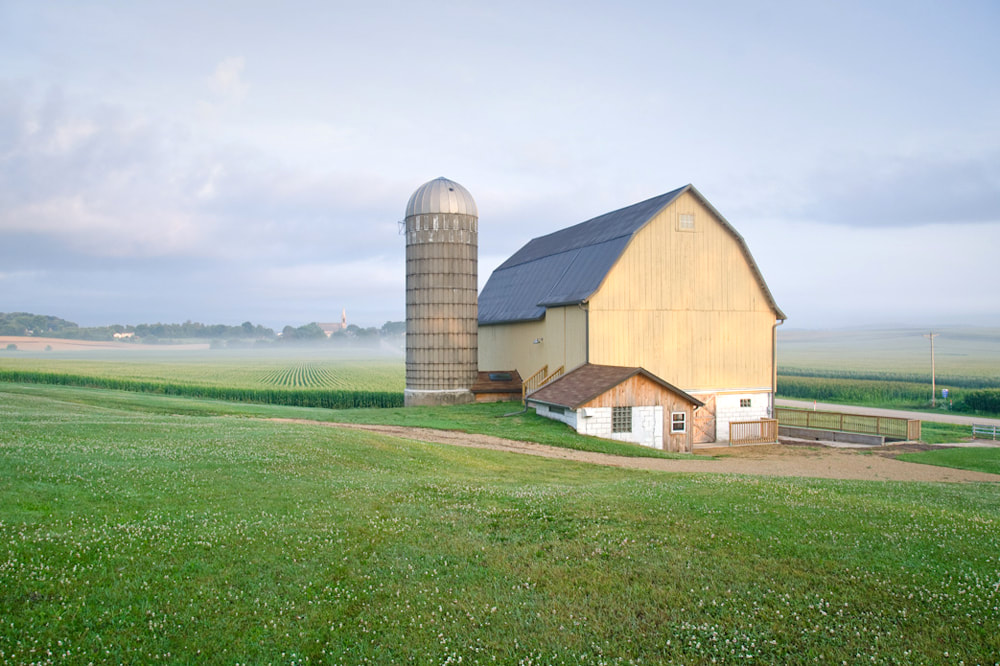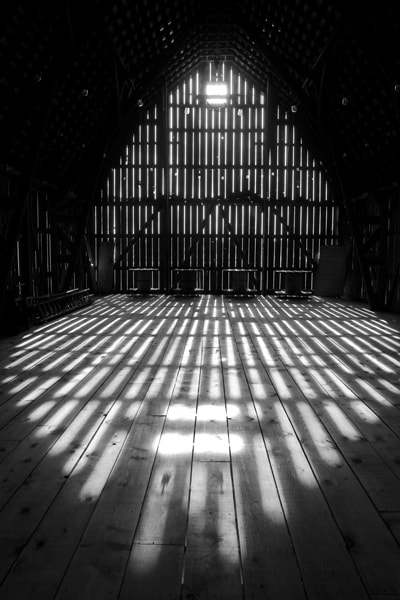|
Though I’ve spent a chunk of my life in one and I’ve been asked sarcastically a few times if I were born in one, I’m not an expert on barns. That would be Jerry Apps, author of Barns of Wisconsin. When I need help recalling the types of barns we’ve had on The Old Brabender Place or the shapes of their rooflines, I just pull out my dog-eared 1977 edition, beautifully illustrated by Allen Strang, to find all I need to know about old barns like ours.  Brother Barn at dawn, with hay barn lights aglow. Brother Barn at dawn, with hay barn lights aglow. According to Apps, our current barn is a “bank” barn, which means that it has two floors (a foundation floor and a haymow) and was built against a hill, which made it possible to form an earthen ramp on the hill side, giving horses and tractors drive-in access to the second floor so we could unload hay or thresh corn and grain there more easily. The first barn on our farm was also a bank barn; the second was a modified bank barn: built on flat ground, with dirt hauled in to form an earthen ramp to the haymow. As for the roofs, the first two were “gabled.” If you look at such a barn from one of its ends, the two lines of the roof coming down from the peak form a perfect upside down “V.” Our third barn, built in 1941 after the second was destroyed by fire, has a “Dutch gambrel” roof. If you were to take that same V-shaped gable roof, add a hump in the middle of each side and finish each bottom with a flip or a curl, you would have a Dutch gambrel (see photo). This roofline added interesting design elements, and extra room or headspace for more hay, straw, or chopped corn stalks. Our first barn, 32 x 36 feet and built around 1865, had a fieldstone-and-limestone wall foundation but a dirt floor. Each wall was about two feet thick. In 1908, its second floor, the haymow, was lifted off in one piece and placed on top of a new poured concrete foundation nearby, and enlarged to 32 x 72 feet to form the second barn. The first barn became a shed for farm machinery, with a new flat metal roof and three large sliding doors that replaced the north wall. Apps calls old barns like the three that have graced our homestead “testimonials to the farmer’s values,” “symbols of farm life” and “history books in red paint.” I’ve grown fond enough of our last standing barn to call it Brother Barn. It, too, has a history and stories to tell, which I'm sharing through entries in this blog. I'll alert you when each one is posted. Bibliographic note: In 2010, The Wisconsin Historical Society published a new edition of Barns of Wisconsin by Jerry Apps, with great photos by his son Steve. Author’s note: I upload posts as I complete them, so one written about a recent event may precede posts about earlier events. The introduction to each post shows where it fits into the history. For an introduction to my memoir, visit Whole Hearted - A Farm Love Story.
0 Comments
Leave a Reply. |
IntroductionThis blog is a book in the making. If you're a new visitor, read Whole Hearted - A Farm Love Story. You can also find a copy in Prologue.
ChaptersPrologue
Father Land Mother Land Father Farm Mother House Brother Barn Sister Silo Granny Granary Epilogue All Archives |


 RSS Feed
RSS Feed